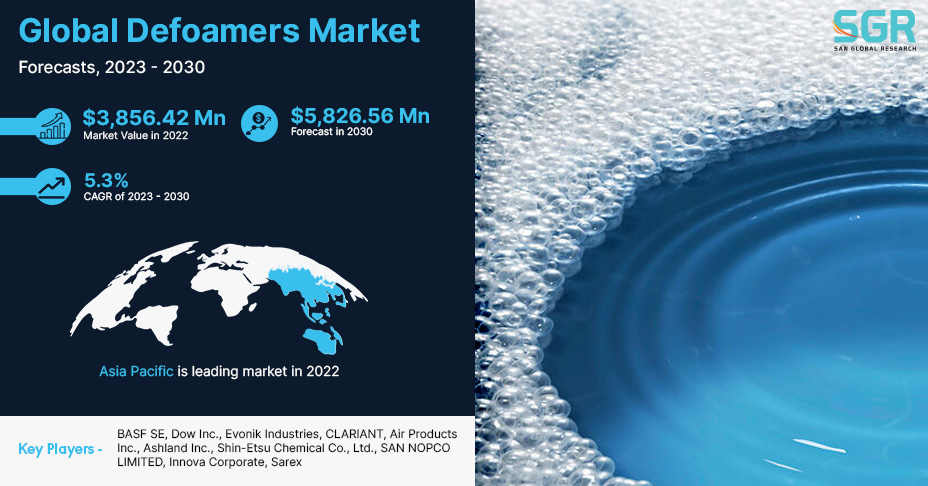Why Defoamers Are Essential in Water Treatment and Waste Management
Why Defoamers Are Essential in Water Treatment and Waste Management
Blog Article
Discover the Top Advantages of Using Defoamers in Industrial Processes
The usage of defoamers in commercial procedures presents a range of compelling advantages that can enhance functional performance and item quality. By efficiently managing foam manufacturing, these representatives not just maximize material circulation yet additionally contribute to significant cost reductions and improved sustainability. The ramifications of embracing defoamers might be more profound than at first viewed.
Enhanced Refine Performance
Maximizing commercial procedures often involves dealing with lathering problems, which can impede operational efficiency. Foam formation can disrupt the correct performance of devices, minimize the efficient use of resources, and complicate the monitoring of important criteria. By applying defoamers, markets can successfully alleviate these problems, resulting in streamlined procedures and enhanced performance.
Defoamers job by destabilizing the foam structure, permitting rapid collapse and substantial decrease in foam volume. This action not just improves the circulation of products with tools, such as pipelines, activators, and mixers, however also minimizes disturbances triggered by foam overflow. Equipment downtime is reduced, permitting for a more continual and effective production procedure.
Additionally, using defoamers can result in lowered energy intake. With less foam to take care of, compressors and pumps can operate a lot more successfully, resulting in reduced operational prices and an overall enhancement in process throughput. Eventually, the strategic use defoamers not only addresses prompt foaming difficulties yet also adds to a more effective commercial community, cultivating a competitive benefit in a requiring market.
Improved Product High Quality
The assimilation of defoamers in industrial processes plays a critical role in boosting product high quality. By properly controlling foam formation, defoamers add to the uniformity and harmony of final products. Extreme foam can lead to aeration, which negatively affects the appearance and security of formulations, particularly in markets such as food and drinks, pharmaceuticals, and finishings.

Additionally, defoamers help with better blending and dispersion of active ingredients, causing homogeneity in formulations. This is crucial in applications where exact ingredient proportions are essential for efficiency and safety. In addition, the elimination of foam can lower the risk of contamination throughout production, more protecting item honesty.
Ultimately, by boosting product high quality, defoamers not only improve customer fulfillment but likewise reinforce brand name credibility. Their duty in maintaining top notch standards highlights their relevance in contemporary commercial procedures.
Cost Decrease Benefits
Applying defoamers in commercial processes can cause substantial cost reduction advantages. By properly controlling foam development, defoamers minimize product loss during production, therefore optimizing material usage. This decrease in waste converts straight into reduced basic material prices, enhancing overall operational effectiveness.
In addition, using defoamers can decrease energy usage. Too much foam can hinder equipment performance, resulting in boosted power needs to keep manufacturing degrees. By mitigating foam, defoamers help with smoother procedures, permitting equipment to run extra successfully and lowering power expenses.

In addition, defoamers can reduce handling times. By making use of defoamers, sectors can streamline their processes, leading to faster turnaround times and enhanced throughput.

Environmental Effect Reduction
In commercial processes, using defoamers plays a critical role in mitigating environmental impacts connected with foam generation. Foam can bring about substantial functional inadequacies, resulting in enhanced discharges and waste generation. By properly regulating foam, defoamers help maintain procedure effectiveness, therefore reducing the overall environmental footprint of operations.
Furthermore, extreme foam can overflow containment systems, causing spills that might contaminate soil and water resources. Defoamers help reduce this risk by guaranteeing that lathering does not surpass recommended limitations, promoting compliance with environmental guidelines. This aggressive strategy not just safeguards ecological communities yet additionally boosts the sustainability of industrial methods.
Additionally, the use of defoamers can lower power usage in various processes. defoamers. Lowering foam development reduces the requirement for additional energy-intensive measures, such as increased frustration or pumping, which might otherwise be this website necessary to take care of foam. Subsequently, the adoption of defoamers straightens with broader sustainability objectives by advertising energy efficiency while minimizing the carbon impact of industrial activities.
Eventually, integrating defoamers right into industrial procedures is a calculated step that sustains environmental stewardship and responsible source management.
Convenience Across Industries
Throughout different sectors, defoamers demonstrate remarkable flexibility, adjusting to the certain needs of varied applications. In the food and drink market, for instance, defoamers are critical to preserving item quality by protecting against foam formation during handling, which can affect structure and taste. Likewise, in the pharmaceutical sector, defoamers ensure the security of solutions, improving item efficacy and consistency.
In the chemical production world, defoamers help with smoother procedures by minimizing foam in response vessels, thus boosting return and minimizing downtime. The paper and pulp sector relies upon defoamers to improve the performance of pulp handling and paper production, guaranteeing ideal item integrity. In addition, in wastewater treatment facilities, defoamers play an important duty in controlling foam during aeration processes, causing better treatment outcomes.
The flexibility of defoamers reaches the oil and gas sector, where they aid in taking care of foam in drilling fluids and production processes. By tailoring solutions to meet specific industry requirements, defoamers serve as important tools that enhance operational efficiency, product quality, and overall procedure efficiency throughout a wide variety of markets. Their versatility highlights their value in contemporary industrial applications.
Conclusion
Finally, the application of defoamers in commercial processes provides numerous benefits, consisting of enhanced check this site out performance, enhanced product top quality, considerable cost decreases, and favorable environmental impacts. Their capability to efficiently regulate foam development contributes to functional continuity and source optimization. Moreover, the versatility of defoamers throughout diverse sectors highlights their critical function in promoting lasting practices and productivity. imp source The integration of defoamers represents a strategic method to dealing with obstacles connected with foam administration in various producing settings.
Inevitably, the tactical use of defoamers not only addresses instant frothing difficulties yet additionally adds to a more efficient industrial environment, promoting an affordable benefit in a requiring market.
In commercial procedures, the usage of defoamers plays a crucial role in mitigating ecological influences linked with foam generation. By effectively controlling foam, defoamers help maintain process efficiency, thereby reducing the overall environmental impact of procedures.
In addition, in wastewater treatment facilities, defoamers play a vital role in controlling foam throughout oygenation procedures, leading to enhanced treatment outcomes.

Report this page